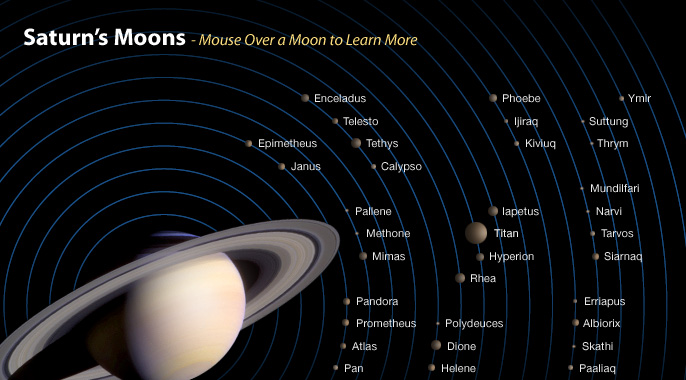 |
 |
So far, 62 moons have been discovered in orbits around Saturn, and 53 of them have been officially named. For the latest moons discovered visit the Recent Discoveries page.
|
 |
 |
|
|
Saturn's Moons
The dozens of icy moons orbiting Saturn vary drastically in shape, size, surface age and origin. Some of these worlds have hard, rough surfaces, while others are porous bodies coated in a fine blanket of icy particles. All have greater or smaller numbers of craters, and many have ridges and valleys. Some, like Dione and Tethys, show evidence of tectonic activity, where forces from within ripped apart their surfaces. Many, like Rhea and Tethys, appear to have formed billions of years ago, while others, like Janus and Epimetheus, could have originally been part of larger bodies that broke up. The study and comparison of these moons tells us a great deal about the history of the Saturn System and of the solar system at large.
To date, 53 moons have been officially named. In alphabetic order, they are: Aegaeon, Aegir, Albiorix, Anthe, Atlas, Bebhionn, Bergelmir, Bestla, Calypso, Daphnis, Dione, Enceladus, Epimetheus, Erriapus, Farbauti, Fenrir, Fornjot, Greip, Hati, Helene, Hyperion, Hyrrokkin, Iapetus, Ijiraq, Janus, Jarnsaxa, Kari, Kiviuq, Loge, Methone, Mimas, Mundilfari, Narvi, Paaliaq, Pallene, Pan, Pandora, Phoebe, Polydeuces, Prometheus, Rhea, Siarnaq, Skadi, Skoll, Surtur, Suttung, Tarqeq, Tarvos, Telesto, Tethys, Thrym, Titan and Ymir.
Astronomers continue to find new small moons orbiting Saturn, using both ground-based observatories and Cassini's own imaging cameras.
For more information on the latest moons discovered visit the Recent Discoveries page and the Icy Satellites publications listing.
Diversity of Worlds
The moons of Saturn are a diverse collection. Cassini has explored their icy landscapes in unprecedented detail, solving long-standing mysteries and sharing many new surprises: Iapetus has an enormous ridge along its equator in addition to its two sides of remarkably different brightness. Rhea may have its own faint rings. And sponge-looking Hyperion is so porous that impacts tend to just punch into the surface, and its gravity is so low that what material does get ejected tends to leave the moon altogether.
In some ways, the moons Titan and Enceladus have turned out to be the stars of the Cassini mission. Titan, with its thick atmosphere, clouds, and dunes on its surface, plus rivers and lakes of liquid methane, is a rich laboratory for chemistry and processes that may resemble early Earth in a deep freeze. And with its towering south polar plume of icy particles, Enceladus has geologic activity, simple organic compounds and possibly liquid water beneath its frozen surface, making it incredibly important to the study of potentially habitable environments for life. Both of these moons are tempting targets for future exploration.
|
 |
|
|
 |
|
Finding new moons orbiting a planet as distant as Saturn is a game of patience and hard work.
Whether they use ground-based telescopes or the cameras onboard a spacecraft like Cassini, astronomers basically use the same technique: they painstakingly compare images of the sky taken at different times looking for anything that moves between exposures. Because stars are so far away, they don't move with respect to each other in an image – but anything out of place could represent a newly found object. If the position and orbit of a celestial body are unique, astronomers publish the findings. Later verifications assure the candidate moon gets a definitive name.
Cassini focuses its cameras mainly on objects relatively close to Saturn, including the rings, where it discovered the embedded moon Daphnis in 2005. Moons orbiting near or in the rings are especially interesting to scientists studying the rings, who observe the effects of the moons' gravity on ring particles.
Earth-based observations, on the other hand, focus on the outer part of the Saturnian region. The moons found in recent years by Earth-based telescopes tend to be small and on highly inclined orbits – paths around Saturn that are tilted with respect to the planet's equator – and highly elliptical orbits – paths shaped like stretched ovals. Many such moons also have retrograde orbits, meaning they travel around Saturn in the opposite direction compared to most of the other moons and the direction the planet rotates. The unusual orbits of these oddball outer moons provide hints at their identities; they are likely captured objects that strayed too close to Saturn and became ensnared by its gravity.
|
|
 |
How do moons get their exotic names? Who makes the final decision? For practical reasons, a new moon is given a working title that astronomers use to identify it while waiting for its official name.
This temporary name usually consists of the year of discovery and a number indicating the order of discovery in that year. In the case of Saturn's moons, these provisory names follow the format S/2005-S1, S/2005-S2 etc. The first "S" (before the slash) is for Saturn. The second "S" (after the dash) is for satellite. Once the existence of the moon is confirmed and its orbit determined, the moon is given a final name by the International Astronomical Union, the organization that since 1919 assumed this task. While anybody can submit suggestions, the final decision is made by a committee within the organization called the Working Group for Planetary System Nomenclature .
Names usually come from characters in Greek and Roman mythology. In the case of Saturn, most moons are named after Saturn's brothers, the Titans, and Saturn's sisters, the Titanesses. These were mythological giants who were believed to rule in the heavens before Jupiter conquered them. Seventeen of the earliest discovered moons of Saturn bear those names (plus giant Titan, which was the first of these moons to be detected). Other small moons discovered in recent years have been named for Inuit, Gallic and Norse gods and goddesses.
|
|
|
